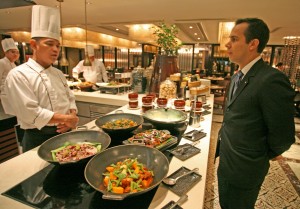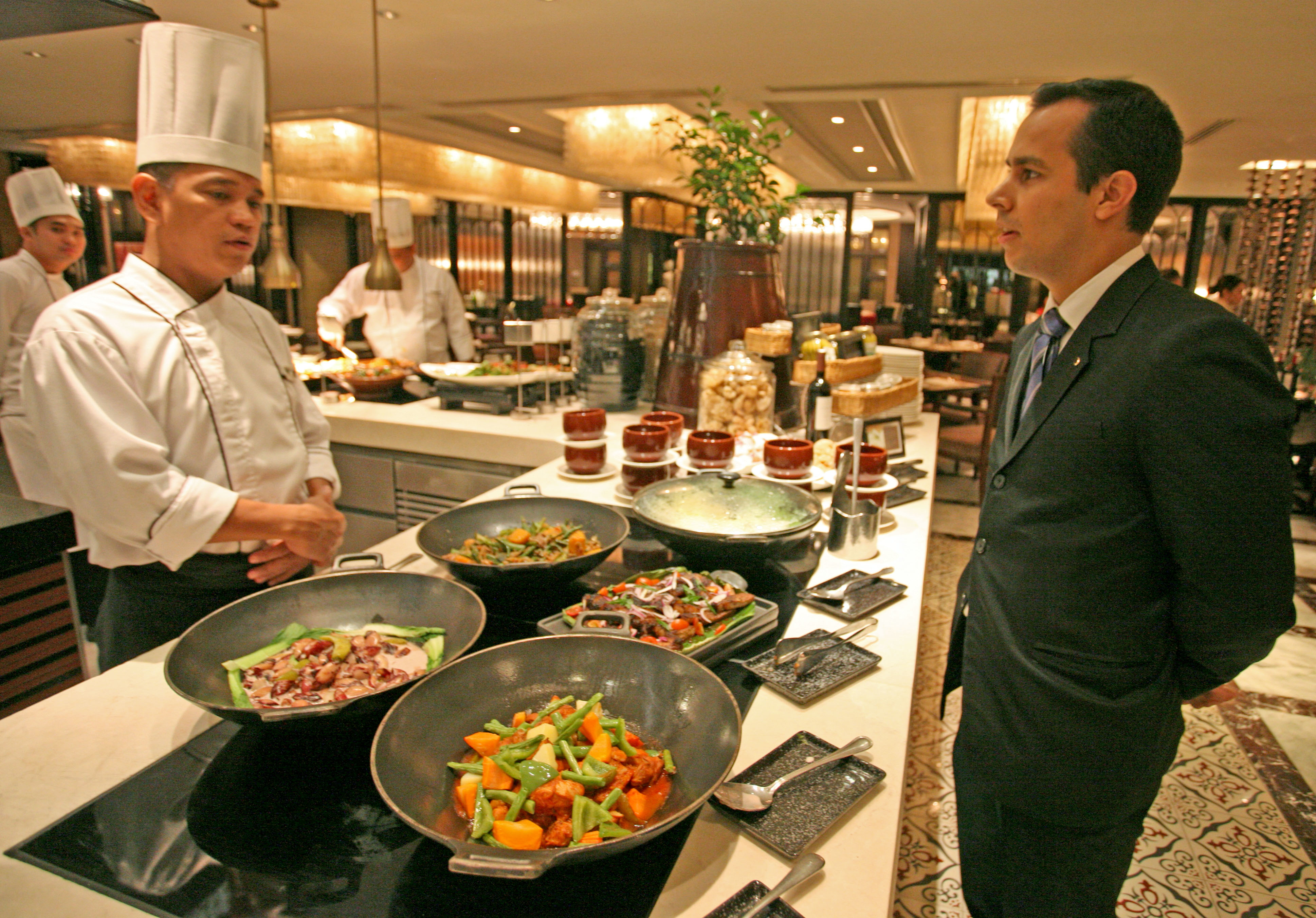
No typhoon can stop a determined diner.
When “Ruby” struck last weekend, we thought it would be slack hours and a lazy Sunday brunch at Spiral restaurant in Sofitel Philippine Plaza at the CCP Complex, since it was on Roxas Boulevard and people might get discouraged to eat out for fear of storm surges.
As it turned out, diners were flocking half an hour before Spiral’s 21 food ateliers opened, and this despite the P4,200+ tag on the buffet. This was the first in a series of special Sunday brunches (12 noon-3 p.m.) the restaurant is offering for the holidays.
“Gastronomy and wine are pillars of Sofitel,” says Tanguy Gras, who manages the luxury hotel’s dining outlets. “For the holidays, we highlight festive food, like special cheeses, premium wines, the turkey”—of which Spiral has a decadent version, the big bird stuffed with duck which is in turn stuffed with chicken and foie gras.
Spiral, a concept restaurant with 452 indoor and outdoor seating capacity, aims to “bring the authenticity and warmth of the traditional French markets and Asian hawker stalls into a five-star hotel setting.” The dishes are prepared by 60-80 chefs. The result is an astonishing mix of world cuisines a diner would run out of breath just to navigate.
The food ateliers comprise Salad and Appetizer; L’Écailler (fresh oysters from Aklan and France, mussels from New Zealand); Sushi and Sashimi; L’Épicerie (European cheeses, hams, sausages, cold cuts); Hot Japanese; French Stove; Rotisserie; Wood-Fired Oven; Churrasco (grilled meats, barbecues); North Indian; Asian Noodles; Peking Duck Oven; Steam Baskets; Chinese Wok; Filipino; Thai; Korean; La Boulangerie; La Patisserie; Chocolaterie; Creamery.
Unique concept
This concept of a series of dining ateliers and cooking stations is “something really unique,” says Gras. It has earned Sofitel’s flagship restaurant a reputation as one of the most dynamic interactive-dining destinations in Asia-Pacific.
“Friends from France who visited me—some also in the restaurant business—were amazed,” says Gras. “They found it only here in Manila. Our biggest come-on is the sheer variety in the choices of food. We serve over 300 dishes every meal, and there’s a chef for every section. Our success is in that you see the food being prepared, as it happens—you call that à la minute. People come here not only to eat but also to be entertained.”
Bettina Margaret Arguelles, Sofitel’s sous chef with a specialization in French cuisine, says other establishments are coming up with a similar concept— “maraming nagka-copy”—but Spiral remains distinctive.
Gras’ favorites from the ateliers include the Fine de Claire oysters, cultured on the French Atlantic coast, small but fleshy and juicy, crisp, slightly nutty, and balanced in saltiness, which he recommends best eaten raw with vinegar or lemon and shallot; the Vietnamese noodle soup; and the Singaporean chili crab, a signature dish.
In his two-and-a-half-year stay in the country, has he taken to rice? “I have no problem with that,” he smilingly says. “My mother is from La Reunion, a French island near Madagascar.”
Exotic food
Does Spiral also offer exotic food to diners? “I just had mangosteen at breakfast,” he says. Balut? “Sometimes, for special occasions. I like it, actually.”
But nothing like crisp-fried scorpion, wormy cheese or kangaroo steak. Arguelles says they regularly hold meetings and briefings for consensus on what’s to be included on the menu, and to consider how many complaints they get.
Because an innocent dish like dinuguan (blood stew) may turn off some Spiral diners, of which she estimates 30-40 percent are foreigners or expats, mostly British and Europeans, with the Filipino-Chinese comprising the bulk overall. Even if the balut (duck embryo) has been turned into a soufflé, they still have to determine: Does it sell?
“Our diners are really open-minded,” says Gras. “Filipinos are easy to please.”
Some complaints from diners Arguelles finds amusing, as when an upset lady once grumbled: “Ang laki-laki ng buffet n’yo wala kayong sea bass?”
Says Arguelles: “Hindi araw-araw may sea bass. Hindi araw-araw may scallops. There’s big expectations because we’re pricier. But it’s just not possible to have them every day.”
Cuisine appreciation
Arguelles, who had worked for seven years in Singapore before returning to the country to take charge of the menus for Sofitel’s various dining outlets, says the level and standard of diners is higher in Singapore as it is more cosmopolitan and has a lot of expats.
“They’re very particular with the quality of ingredients, the temperature of the food,” she says. “Their level [of cuisine appreciation] is elevated already as in New York, because they have a lot of celebrity chefs.
“But in terms of service, we are better. I think we’re already catching up, due to the popularity of these [culinary] TV shows. We’re now open to different cuisines. There’s a boom in the food industry. I’m surprised by the spending power here. Spiral is always full.”
Arguelles oversees over 200 chefs during the Christmas season, banquets and events. She’s particular with the cycles in the menu and sees to the regular coordination of the atelier chefs.
“Para hindi sabay [the foods for the day],” she explains. “Hindi puwede na lahat seafood. And there should be no similarities, as with Filipino and Chinese noodles, or the chop suey [with all its variants].”
Quintessential dish
She’s especially proud of the French ateliers. “French culture is part of the DNA of the [Sofitel] organization,” she says.
La Boulangerie offers nothing but freshly baked premium breads, baguettes, croissants, Spiral’s signature olive bread.
La Patisserie and Chocolaterie, with their extravagant arrays of sweets and pastries, evoke the salons de thés à Paris.
The French Stove, where dishes are cooked in the traditional royal-blue Bonnet oven, prepares the foie gras, duck confit, stews—and Arguelles’ favorite braised beef short ribs, the quintessential French dish boeuf bourguignon.
Here also is prepared the similarly noble coq au vin, chicken slow-cooked in red wine and butter, tomato, garlic, herbs, mushroom, carrot, bacon. It is a four-day process of alternating steps of simmering and airing. It is served only at Le Bar on the hotel lobby.
“’Yan ang binabalik-balikan ng ibang guests sa lobby,” says Arguelles. “One British guest swore it’s authentic, and it’s hard to find outside of France.”
Foie gras is served in slivers on chutney or risotto in a delicate shortcrust pastry, for guests to have a different experience of flavor profiles, says Arguelles.
Artisanal cheeses
L’Épicerie is a little store carrying cheeses and charcuterie from France, Italy, Germany and Switzerland. It is also called The Cheese Room as it is more reputed for its artisanal cheeses.
Arguelles especially recommends the ancient Comté and Fourme d’Ambert; the creamy Camembert and Brie; the Reblochon; the goat cheeses Crottin and Sainte-Maure; the sheep-milk blue cheese Roquefort.
“Even foreigners get awestruck when they see it,” she says. “I think this is the only one of its kind in Asia. It is heavy on French cheeses. They’re not produced in bulk. They really come from the farmers. So you get respect for each cheese, its history, where it comes from, the story of the cheese-maker.”
The Wine Cellar stocks on premium French champagnes as well as wines from Spain, Italy, Chile, Australia, France. Champagnes and sparkling wines, plus cocktails, beverages and cognac, are served at Sunday brunch till 2 p.m.
Arguelles also recommends the teppanyaki and the Indian dishes, among her personal favorites.














































